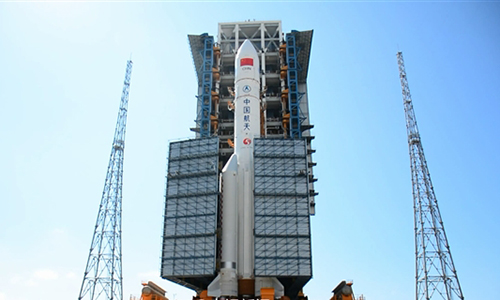

 |
| Long March-5 rocket Photo: CNTV.com |
China will launch its largest and most powerful carrier rocket, the Long March-5 Thursday afternoon amid rising demand to fuel its space ambitions.
The rocket, which arrived at the Wenchang launch center in South China's Hainan Province in September, was transported to the launch pad Friday morning, after undergoing final assembly and tests, the Xinhua News Agency reported, citing the State Administration of Science, Technology and Industry for National Defense (SASTIND).
According to the SASTIND, the Long March-5 integrates top space technologies, including non-toxic environmentally friendly fuel and a highly stable control system, representing a landmark in the country's carrier rockets.
"After the launch of the Long March-5, China will launch a series of 20-ton rockets, including the Long March-5, 6 and 7," Wang Xiaojun, commander-in-chief of the Long March-7, told the Global Times.
For the first time, the Long March-5 uses liquid hydrogen and liquid oxygen as fuel, and was expanded to 5 meters in diameter, compared to 3.35 meters in previous rockets, China Science Communication reported.
Zhao Changjian, a research fellow at the first research center of the China Aerospace Science and Technology Corporation, told the Global Times on Wednesday that using liquid hydrogen and liquid oxygen as fuel is the most advanced in the world.
"If the launch succeeds, China will enter an era of environmentally friendly rockets," Zhao said.
Zhao also noted that the Long March-5, which is capable of carrying 25 tons into low Earth orbit, is capable of carrying two and a half times more payload than China's previous rockets.
According to Zhao, the Long March-5 belongs to the large rocket series and the country will also develop smaller rockets as well as even larger rockets with a payload capacity of more than 50 tons in the future.
The development of larger-payload rockets will help support China's space ambitions. Wang said after completing the first two steps in manned space flights, China will build its own space station between 2022 and 2024 and would be the only space station in the world after the US' space station retires.
A special team consisting of China's top aerospace scientists delivered a report in August 1992 that described the three steps in developing China's manned spaceflight technology. The first is to develop a manned spacecraft and support systems, and to put China's first astronaut in space and return safely. The second is to grasp space docking technology, which would finally lead to a temporarily manned space laboratory. And the third stage would see China build a 20-ton permanent space station.
"China's space industry started late and is not as mature as those of the US and Russia," said Wang. In the 1970s, when China launched its first rocket, the Long March-1, the US had already sent astronauts to the moon.
However, Wang said China's space industry has reached international standards after nearly 50 years of development, especially in the last decade.
According to Wang, China has launched roughly the same number of rockets annually as the US in recent years, though slightly fewer than that of Russia.
Wang said one of the advantages of China's space technology development is China has a younger backup team than the two other countries.
The Long March-5 will undergo further tests before being launched, according to Xinhua.
 |
 Fire brigade in Shanghai holds group wedding
Fire brigade in Shanghai holds group wedding Tourists enjoy ice sculptures in Datan Town, north China
Tourists enjoy ice sculptures in Datan Town, north China Sunset scenery of Dayan Pagoda in Xi'an
Sunset scenery of Dayan Pagoda in Xi'an Tourists have fun at scenic spot in Nanlong Town, NW China
Tourists have fun at scenic spot in Nanlong Town, NW China Harbin attracts tourists by making best use of ice in winter
Harbin attracts tourists by making best use of ice in winter In pics: FIS Alpine Ski Women's World Cup Slalom
In pics: FIS Alpine Ski Women's World Cup Slalom Black-necked cranes rest at reservoir in Lhunzhub County, Lhasa
Black-necked cranes rest at reservoir in Lhunzhub County, Lhasa China's FAST telescope will be available to foreign scientists in April
China's FAST telescope will be available to foreign scientists in April "She power" plays indispensable role in poverty alleviation
"She power" plays indispensable role in poverty alleviation Top 10 world news events of People's Daily in 2020
Top 10 world news events of People's Daily in 2020 Top 10 China news events of People's Daily in 2020
Top 10 China news events of People's Daily in 2020 Top 10 media buzzwords of 2020
Top 10 media buzzwords of 2020 Year-ender:10 major tourism stories of 2020
Year-ender:10 major tourism stories of 2020 No interference in Venezuelan issues
No interference in Venezuelan issues
 Biz prepares for trade spat
Biz prepares for trade spat
 Broadcasting Continent
Broadcasting Continent Australia wins Chinese CEOs as US loses
Australia wins Chinese CEOs as US loses